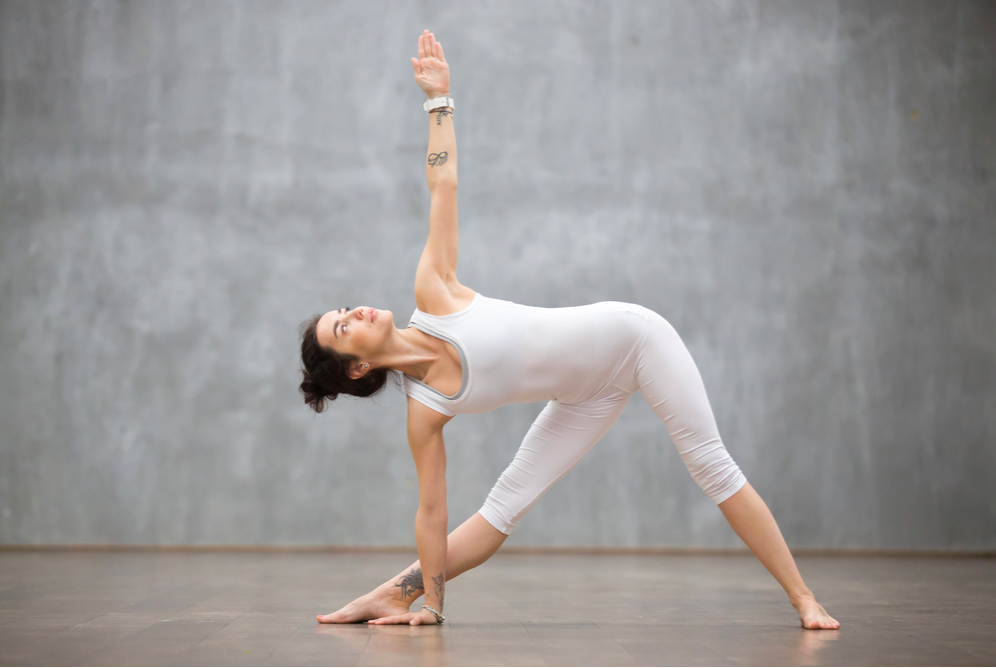
Indeed, yoga is not only a physical exercise, it is also a philosophy of health, life and spiritual experiences at a higher level. Let’s find out 11 benefits of yoga, especially the effects of practicing yoga with women!
1. What is the effect of practicing yoga? Helps relieve stress
Yoga is known for its ability to reduce stress and promote relaxation. Many studies have shown that practicing yoga reduces the secretion of cortisol, the main stress hormone. There was a factual study of 24 women who identified themselves as always having difficulty or suffering emotionally.
After a three-month yoga program, the women had significantly lower cortisol levels. They also had lower levels of stress, anxiety, fatigue and depression. This improves quality of life and mental health.
If you are wondering what yoga is for, when you look at actual studies, you will find that yoga is an effective method to manage stress in a scientific way.
2. Helps relieve back pain

If you have to sit at work all day and often suffer from back, neck and shoulder pain, yoga is a great solution to this problem. Basic stretches help reduce pain and improve mobility in people with lower back pain. The American College of Physicians recommends yoga as a first-line treatment for chronic low back pain.
The yoga movement that helps you relieve back pain is the cat-cow pose. You can practice as follows: Get into a crawl position, hands and knees touch the floor. First, you inhale, with your head in a comfortable position, and looking up, pushing your butt up while your back sags. Hold for a few seconds, exhale. Then you hunch your back like a cat stretching. Hold for a few seconds and then repeat from the beginning.
3. Benefits of yoga in reducing anxiety
Similar to stress, the effect of practicing yoga with women in particular and people in general is to help reduce anxiety.
One study was conducted on 34 women who were diagnosed with an anxiety disorder. They were divided into 2 groups, one group attended yoga classes twice a week for 2 months. At the end of the study, those who practiced yoga had significantly lower anxiety levels than the control group.
In addition, there was another study of 64 women with post-traumatic stress disorder (PTSD), characterized by severe anxiety and fear following exposure to a traumatic event. After 10 weeks, the women who did yoga once a week had fewer symptoms of PTSD. In fact, 52% of the participants no longer met the criteria for PTSD.
Being “present” in the present moment and delving into the peaceful feeling of yoga is an important way to help treat anxiety.
4. The use of yoga in reducing inflammation

Inflammation is a normal immune response, but chronic inflammation can contribute to the development of diseases like heart disease, diabetes, and cancer. On this topic, a 2015 study divided 218 participants into two groups: those who practice yoga regularly and those who do not. As a result, those who practiced yoga had lower levels of inflammatory markers than those who did not.
Similarly, a 2014 study found that after 12 weeks of yoga, inflammatory markers in breast cancer survivors were significantly reduced, and persistent fatigue was also improved.
5. Yoga improves heart health
Heart health is one of the key factors in the overall health of the body, as it is responsible for pumping blood throughout the body to supply tissues with important nutrients. Studies show that yoga can help improve heart health and reduce several risk factors for heart disease.
One study found that people over 40 who practiced yoga for 5 years had lower blood pressure and heart rate than those who didn’t. Accordingly, high blood pressure is one of the main causes of heart problems, such as heart attacks and strokes. Lowering blood pressure with yoga can help reduce the risk of these conditions.
Combining yoga with a healthy lifestyle can help slow the progression of heart disease. A study of 113 patients with heart disease looked at the effects of lifestyle changes that included a year of yoga practice combined with dietary modifications and stress management. The results were amazing, with participants seeing a 23% reduction in total cholesterol and a 26% reduction in bad cholesterol. In addition, progression of heart disease stopped in 47% of patients.
6. What effect does yoga have in improving quality of life?

Yoga is becoming increasingly popular as a supportive therapy to improve the quality of life of so many people. Scientific studies have even found that yoga can help improve sleep quality, lift mood, improve social functioning, and reduce symptoms of anxiety and depression in cancer patients. .
One study followed women with breast cancer who were undergoing chemotherapy. Yoga reduces symptoms of chemotherapy, such as nausea and vomiting, and improves overall quality of life. After eight weeks of training, they experienced less pain and fatigue, increased energy, and reduced anxiety.
7. The use of yoga in fighting depression
Some studies show that yoga has antidepressant effects and may help reduce symptoms of depression. This is because yoga can lower levels of cortisol, a stress hormone that affects serotonin, the neurotransmitter associated with depression.
In one study, participants in an alcohol detox program practiced a breathing-focused yoga approach. After two weeks, the participants had fewer depressive symptoms and lower cortisol levels. They also had lower levels of ACTH, a hormone responsible for stimulating the release of cortisol.
8. Yoga helps relieve chronic pain

Chronic pain is a problem that affects the lives of millions of people for a variety of reasons, from trauma to arthritis.
An increasing number of studies demonstrate that practicing yoga can help relieve many types of chronic pain. In 2005, a study found that yoga can help reduce pain and improve physical function in participants with osteoarthritis of the knee.
Although more research is needed, incorporating yoga into the daily routine improves and reduces pain for people with chronic pain conditions.
9. Improved flexibility and balance
Just 15–30 minutes of yoga a day can make a big difference for those looking to improve flexibility and balance.
There was a study done on this, whereby 66 elderly people were divided into 2 groups, one group practiced yoga, the other group practiced yoga or calisthenics – an exercise that includes many movements that work the muscle groups. great. After one year, the total flexibility of the yoga group increased nearly four times compared with the other group.
10. What is the effect of practicing yoga? Improve sleep quality

Poor sleep quality has been linked to obesity, high blood pressure and depression, among other disorders. Incorporating yoga into your daily routine can help you sleep better. This was demonstrated in a study in 69 elderly patients. They were divided into three groups, one to practice yoga, one to take herbs, and the other to be a control group. The results showed that the yoga group fell asleep faster, slept longer, and felt more relaxed in the morning than the other groups.
The reason yoga benefits sleep quality is because yoga increases the secretion of melatonin, a hormone that regulates sleep and alertness.
11. The use of yoga in reducing migraines
Migraine is one of the recurrent diseases that greatly affects the quality of life. Often, migraines are treated with medication to relieve and control symptoms. However, there is growing evidence that yoga can be a useful adjunct therapy to help reduce the frequency of migraines.
A 2007 study divided 72 patients with migraines into a yoga therapy or self-care group for three months. Practicing yoga helped reduce the intensity, frequency, and pain of headaches compared with the self-care group. Researchers suggest that practicing yoga can help stimulate the vagus nerve, which has been shown to be effective in reducing migraines.
12. What effect does yoga have in increasing strength?

Although not a cardio exercise, yoga is an effective exercise method for strengthening and building muscle.
In one study, 79 adults did 24 cycles of sun salutations – a series of basic poses commonly used to warm up – 6 days a week for 24 weeks. At the end of the study, they were assessed for a significant increase in upper body strength, endurance, and weight loss. Women also reduce their body fat percentage.
A 2015 study had similar results, showing that 12 weeks of training led to improvements in endurance, strength, and flexibility in 173 participants.
13. What is the effect of practicing yoga? Improve your sex life
Yoga can bring more fun to the bedroom. A study done in India focused on 40 healthy and sexually active women.
After practicing yoga for 12 weeks, 75% of the participants said they were more satisfied with their sex lives. Yoga helps them increase their libido, helping them achieve better orgasms.
Although the number of participants was small, the results were extremely positive, especially for women over 45 years old.
14. Improve premenstrual syndrome as well as menopause

An article published in the International Journal of Women’s Health and Reproductive Sciences highlights the power of yoga for PMS. The researchers focused on the emotional, behavioral, and physical symptoms associated with PMS.
Studies have also focused on how yoga can help menopausal women deal with hot flashes. 54 perimenopausal and menopausal women experience at least four hot flashes per day. 66% (2/3) of people said they had reduced hot flashes after just 10 weeks of taking yoga classes. At the same time, the hot flashes were less intense than before.
15. Yoga benefits those undergoing breast cancer treatment
Breast cancer charities recommend yoga as a therapy for people living with the disease, to help improve overall quality of life.
A review of all the findings surrounding the impact of yoga on breast cancer symptoms was done in 2012. 12 studies were reviewed, with 742 participants, both patients and adults. survive. Short-term improvements were seen in patients after practicing yoga, which helped reduce stress and anxiety levels.
Unlike other sports, you don’t have to be a really strong and resilient person to practice. Yoga is still right for you if you have health problems, even supporting treatment if you are sick. On a physical level, yoga heals and purifies the body, practicing yoga helps to improve digestion and health problems big and small such as back pain, neck pain, shoulder pain, discs… to blood pressure, heart vascular and even cancer. Just 15-30 minutes a day, your life will be improved miraculously.
Leave a Reply